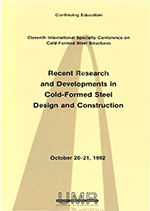Location
Saint Louis, Missouri
Session Dates
20 Oct 1992
Abstract
The size and position of intermediate stiffeners in the compression flanges of thin-walled profiled steel decks exerts a strong influence on the dominant buckling mode of the flange. The ability of the deck to provide both high load carrying capacity before the onset of elastic buckling and a high ultimate load capacity may therefore be affected. A programme of tests to determine the effectiveness of intermediate stiffeners in controlling buckling modes has been undertaken. A series of specimens were loaded in pure bending resulting in various buckling waveforms prior to ultimate failure through a plastic collapse mechanism. All specimens were brake-pressed to designs that were chosen to ensure that the primary buckling took place in the elastic range and was not affected by plasticity. The experimentally determined buckling stresses were found to be comparable with studies performed using a computer analysis based on the finite strip method in which both local and distortional buckling modes were predicted. The test rig developed for the programme successfully approximated the boundary conditions implicit in the numerical model and prevented premature failure due to localised stressing at the specimen ends. A simplified design procedure for distortional buckling is proposed. The existing design procedure for local buckling in the Australian Standard AS1538-1988 is confirmed.
Department(s)
Civil, Architectural and Environmental Engineering
Research Center/Lab(s)
Wei-Wen Yu Center for Cold-Formed Steel Structures
Meeting Name
11th International Specialty Conference on Cold-Formed Steel Structures
Publisher
University of Missouri--Rolla
Document Version
Final Version
Rights
© 1992 University of Missouri--Rolla, All rights reserved.
Document Type
Article - Conference proceedings
File Type
text
Language
English
Recommended Citation
Bernard, E. S.; Bridge, Russell Q.; and Hancock, Gregory J., "Tests of Profiled Steel Decks with V-stiffeners" (1992). CCFSS Proceedings of International Specialty Conference on Cold-Formed Steel Structures (1971 - 2018). 1.
https://scholarsmine.mst.edu/isccss/11iccfss/11iccfss-session1/1
Tests of Profiled Steel Decks with V-stiffeners
Saint Louis, Missouri
The size and position of intermediate stiffeners in the compression flanges of thin-walled profiled steel decks exerts a strong influence on the dominant buckling mode of the flange. The ability of the deck to provide both high load carrying capacity before the onset of elastic buckling and a high ultimate load capacity may therefore be affected. A programme of tests to determine the effectiveness of intermediate stiffeners in controlling buckling modes has been undertaken. A series of specimens were loaded in pure bending resulting in various buckling waveforms prior to ultimate failure through a plastic collapse mechanism. All specimens were brake-pressed to designs that were chosen to ensure that the primary buckling took place in the elastic range and was not affected by plasticity. The experimentally determined buckling stresses were found to be comparable with studies performed using a computer analysis based on the finite strip method in which both local and distortional buckling modes were predicted. The test rig developed for the programme successfully approximated the boundary conditions implicit in the numerical model and prevented premature failure due to localised stressing at the specimen ends. A simplified design procedure for distortional buckling is proposed. The existing design procedure for local buckling in the Australian Standard AS1538-1988 is confirmed.



